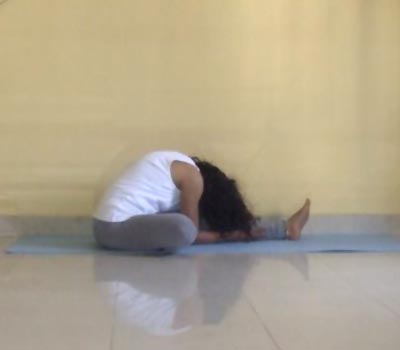
Insomniacs have one nightmare: not falling asleep when they hit the bed. This can become a high anxiety state that does not quite find relief through sleeping pills. Yoga offers a natural and soothing way in which to control this anxiety-producing condition.
Insomniacs suffer from more than just lack of sleep. Research suggests that those with disturbed sleep patterns had significantly higher blood levels of stress hormones adrenocorticotropic hormone (ACTH) and cortisol not just while awake but also when asleep. Investigators concluded this to be the double whammy, causing the study group's obesity, reduced muscle mass, depression, memory loss, osteoporosis, diabetes, blood pressure. It hastens aging (due to stress which breeds damaging free radicals), while also causing near-miss or dangerous accidents, particularly by sluggish drivers or health-care professionals.
Yoga can help. The forward bending poses (highly recommended for people suffering from insomnia) work on the pineal gland, whose production of the sleep hormone melatonin is crucial in inducing sleep. The gush of blood to the head also has a physiologically soothing effect. The forward bends induce deep belly breathing that in turn calms an agitated nervous system.
Shameem Akthar, yoga acharya trained with the Sivananda Vedanta Yoga Center, suggests four poses that will help you sleep better. Catch more of Shameem's yoga writings or upcoming workshops from https://jaisivananda.blogspot.com
This article only attempts to enthuse readers towards yoga practice and complement your existing practice. Yoga is best learnt under the personal guidance of a teacher.

Sit on your heels, so that your hips are rested on your heels which are flared. Inhale and raise your arms overhead. Exhaling, lower them, simultaneously lowering your head so your forehead is rested on the ground in front. Place your hands alongside your body (see photo). Rest in this pose, breathing normally. Initially stay only for a few seconds. Slowly you may learn to increase the time, to half a minute or so, over several weeks. Doing this before going to bed can be restful and calming.
Benefits: Soothes anxiety. Enhances breathing capacity by the pressure applied on the abdomen and the diaphragm. The brain is completely relaxed due to the gush of blood to head. The blood flow to the chest region, including lungs is also greater, allowing that area to rejuvenate.

Sit on the floor. Extend your legs, with your right leg bent at the knee and the right sole placed against the left thigh. Inhale. Raise both your hands. Exhaling, lower your hands to the right foot. Simultaneously lower your head to place it on the right thigh. That may not be possible initially, so just lower your head as much as you can. Continue normal breathing throughout. Inhale, raising your head and hands to return to starting position. Repeat thrice. Then repeat the entire sequence for the left leg.
Avoid: In case of lower back problems and high blood pressure.
Benefits: Body-mind tension is ironed out gently. The pressure on the abdomen helps rejuvenate the islet of Langerhans, the pancreas and adrenal gland. It is soothing due to the increased blood flow to the head and improved belly-breathing.

Sit on the floor with your legs stretched out. Exhaling, lower your hands towards your feet, holding your legs where you can. Drop your head, so it is resting on your thighs. You may also place a bolster on your thighs on which you may rest your forehead. Breathing normall, hold this final pose in a relaxed fashion, for a few seconds initially. After a few weeks of steady practice you may hold the final pose for longer -- half a minute or so.
Avoid: If having very high blood pressure, cardiac problems or severe lower backache.
Benefits: Massages the adrenal gland, helps rejuvenate it. Relieves stress, prevents insomnia. Is a mood elevator. Therapeutic in diabetes, cervical spondylosis. Is preventive in spinal disorders. Improves breathing and respiratory capacity. Tones legs, fights fat, especially at the hips. Keeps the face glowing, young and wrinkle-free. Works on the entire uro-genital system.

Sit cross-legged (if you are a regular practitioner you may sit in the classic lotus pose). Extend your hands in front placing your palms on the ground. Inhale. Exhaling, bend your torso, bringing your forehead to the floor (you may not be able to touch it, but dip your head low, or place a low stool or bolster on which to rest your head). Continue breathing normally, holding the pose for as long as you can. Relax the hold. Repeat a few times.
Avoid: If having very high blood pressure, cardiac problems or lower backache.
Benefits: It relaxes the upper back, where tension is usually lodged. The rush of blood to head soothes the brain. The spinal stretch relieves and untangles tension knots. Relieves anxiety due to pressure on stress glands. Provides relief in anxiety-induced insomnia.